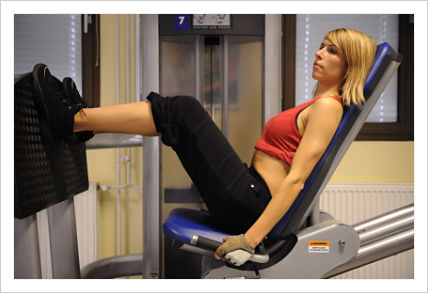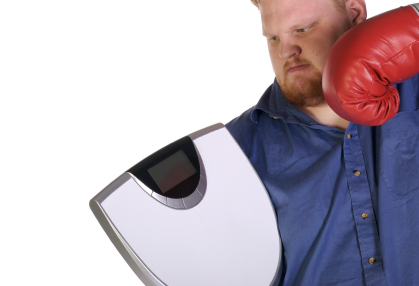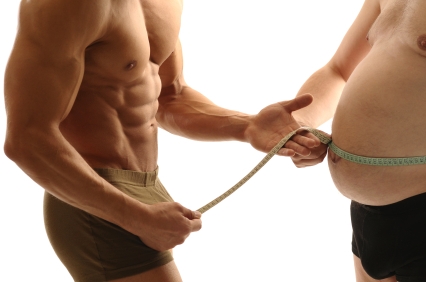7 Gym Vices – Are You a Sinner?
 1. Lazy Lifters – The lazy lifters can be broken down into two distinct subcategories.
1. Lazy Lifters – The lazy lifters can be broken down into two distinct subcategories.
o The first subcategory consists of those who don’t put equipment back where it belongs. This includes offenses such as leaving a dumbbell in the middle of the stretching mat (nothing like rolling over one of these bad boys at the end of a tough workout), or leaving 14-45lb plates on the leg press. Please keep in mind that if you’re big enough to lift it, you’re big enough to put it back where it belongs. Your mother doesn’t work here, you slacker.
o The second type of lazy lifter is made up of those hopelessly clinging to the belief that other gym-goers like to bathe in their sweat, aka those who don’t wipe off equipment. Not only is this damn nasty, it’s also very unsanitary. Beware of this type of lazy lifter. It’s because of their very existence that I recommend always wiping down the machines you use both before, and after you use them. Think I’m being excessive? One bout of ring worm, E. coli, strep-bacteria, or the influenza virus will probably turn even the most adamant skeptic into a believer. Can you say fungus amongus?
2. Phonies – Nothing snaps you out of your fitness zone faster than someone who’s SO important that they HAVE to talk on their cell phone for an entire workout. Though cell phones were once a highly prized status symbol, everybody has them now. You’re no Gordon Gekko! The fact that you feel compelled to talk on your phone the entire workout says that not only are you inconsiderate, but that you also have extremely poor time management skills. Remember that doing all things mediocre usually means doing nothing well. Think delegation and elimination to give your workout the proper attention it deserves.
3. Chatters – Chatters are like phonies, but chatters travel in pairs and are notorious for trying to find cardio machines right next to each other. They talk extremely loud ad nauseum about their personal life, and really seem to have the need to show off the fact that they have one. There’s nothing like a loud conversation full of “Oh, he did not”, or “Yeah, that chick wanted me” to inspire you to cut your cardio session REALLY short. I have no doubt in my mind that chatters are the same people who’ll talk the whole way through a movie. Remember this is your gym, but it’s not “your” gym. Be respectful of others. If you want to workout we’d love to have you with us, but if you want to chat, I hear the coffee shop calling.
4. Pretty Posers – Pretty Posers come to the gym not to work out, but to put on a fashion show. They have all the right clothes and the best fitness shoes on the market, but they’ve never actually used them. Very often posers are also chatters, or phonies. They spend most of their time scanning the gym while doing absolutely nothing, simply in hopes of seeing other gym goers watching them. It’s like they’re looking for an alibi in case they get questioned about a crime or something later in the day. Yes, we think you’re just lovely, but have you heard of a thing called sweat? I hear it’s great for your health.
5. Hogs – Hogs are gym-goers who always use as many pieces of equipment as possible. Though using multiple pieces of equipment is generally acceptable if the gym is slow, and you remember the sharing lesson you should have learned in kindergarten, it’s not OK to cop an attitude if/when someone asks to work in a set. A hog is extremely dangerous and deadly to your workout when they’re also guilty of any of the other six vices. Hogs can effectively double the amount of time it takes for you to finish your routine, so avoid them like the plague. Play nice and share.
6. Monopolizing Squatters – Squatters are those who take forever on a piece of equipment. Some squatters become randomly amazed by their ipod or cell phone for unending amounts of time, while others think that gym machines are the perfect place to catch a few winks. Frustratingly enough their favorite places to carry out these bizarre rituals are nearly always on equipment that’s in short supply, ala the leg curl machine at my gym. Many chatters, posers, and phonies are also guilty of being squatters. Remember, be a spotter not a squatter.
7. Smellies – This vice encompasses a wide variety of gym goers, everyone from those who may have forgotten to shower after yesterday’s workout, to those who slipped, tripped, or by some other means fell into their perfume or cologne bottle. Not only is heavy cologne very irritating to fellow gym-goers, but some are also very allergic to them. If you’re the former smellie we’d like to remind you that while sweat is fabulous to us fitness freaks, day old sweat is past it’s expiration date. You don’t have to be a pretty poser, but keep in mind that most people are relatively immune to their own body odor. Therefore, when it comes to showering, do it before you think you need it.
Not only is allowing these gym vices to invade your fitness journey damaging to the experiences of those around you, it’s also detrimental to your own fitness. There is an undeniably inverse relationship between the number of vices you’re guilty of and the amount of success you’ll experience. In the name of efficient and effective workouts, I urge you to crush fitness vices where ever they lurk in your own routines. If you’re concerned about the vices of others affecting your experience, then have no fear. It appears that there’s also an inverse relationship between the distance from January 1st and the amount of vice in all gyms. Apparently vice is somewhat seasonal.
Did I miss a vice? Now’s your chance to vent away in the comments section below!
Live your dream!
-Matt





Matt,
Very cool.
I had a good chuckle over that.
You always see those people in the gym.
Rick Kaselj of http://ExercisesForInjuries.com
.
Glad you liked it Rick!
I think I’m obliged to bring up the skinny guy who uses the squat rack or power rack for isolation exercises like curls, which they could have done anywhere else in the gym. Fortunately I go to a corporate fitness center right now, so even though I am sacrificing certain equipment, there are virtually no gym sinners where I’m training.
Oh,I’ve definitely seen this one, especially since the resolution crowd started showing up. Monopolizing Squatters of the worst kind.
Sounds like you workout in a heavenly place! Thanks for stopping by Steve!
-Matt
What about this one?
The looker – This is the guy that can’t help but look at the beautiful fitness girl in lycra. In order to try and impress her, he decides to load the bench with more weight – we later see him on youtube under the title – BENCH PRESSES GONE WRONG!
Sin number 8 (that can be an extra one!) – don’t stare.
Great Post.
Hey Dean!
Excellent addition. We could call number 8 “Failure to Impress” aka “The Looker”. Love it! 🙂
Thanks for visiting.
-Matt
HAHA smellies! After reading each one of these sins I could picture it happening at my gym! One of my biggest pet peeves is watching the ladies come in, grab a magazine, and talk to each other as they walk on the treadmill. Total waste of time. And I am all for using gym time as socialization time. I often meet friends (often parents of small children) at the gym to workout and it is often the only time I even see them so we do have a lot to catch up on. But I will say that our workout, nor the workout of others around us, never suffers because of it.
I completely agree with you. One group that I would add to your list is the Farters. Hard to tell which one did the farting but they’re really ruining my personal space. I’m trying to breathe here people.
Oh…your comment made me laugh SO hard! I’ve been under the weather the last week, so I TOTALLY needed that. 🙂
How could I forget the Farters?!
Gyms are a crop duster’s paradise. Full of unsuspecting victims breathing in copious amounts of oxygen. Wouldn’t it be funny if a giant stage hook came down and yanked the culprit off the treadmill?
Fabulous addition! Thanks for visiting and commenting.
-Matt
Sometimes I could think of just setting a home gym instead because of these people. And I also hate those lookers!
lol, you’re so damn hot that you’ve grown tired of so many lookers?!
(haha just messing with ya)
lol, nice article. I have been guilty of #5, but that’s because I do supersets galore! And there’s usually only a few people during lunch time. Anyway, I’ll be more conscientious!
– BUM
This made me laugh! Reminds me why I workout at home most of the time. It’s funny how many people go to the gym just so they can day they do, but have no intention of putting in an honest workout when they are actually there!
Michael